
In the circuit shown, the total current supplied by the battery is
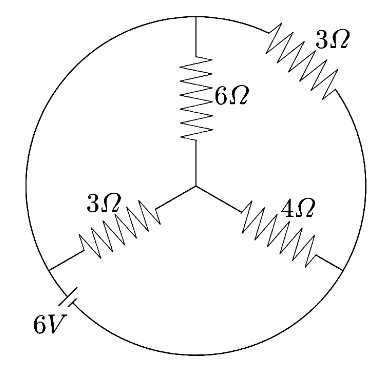
A. $1A\;$
B. $2A\;$
C. $3A\;$
D. $6A\;$

Answer
501k+ views
Hint: We can find the total current supplied by the battery using Ohm’s Law which states that voltage of a battery is the product of the current supplied and the total resistance. To find the total resistance, we need to rearrange the given circuit to understand the series and parallel connections.
Formula used:
Series connection of resistors ${{R}_{eq}}={{R}_{1}}+{{R}_{2}}+...+{{R}_{n}}$
Parallel connection of resistors $\dfrac{1}{{{R}_{eq}}}=\dfrac{1}{{{R}_{1}}}+\dfrac{1}{{{R}_{2}}}+...+\dfrac{1}{{{R}_{n}}}$
Ohm’s Law $V=IR$
Complete step by step answer:
Let us note down the given data,
${{R}_{1}}=3\Omega $ , ${{R}_{2}}=6\Omega $ , ${{R}_{3}}=4\Omega $ , ${{R}_{4}}=3\Omega $ , and $V=6V$
Now, let us name the nodes to understand the series and parallel connections of resistors as shown below,
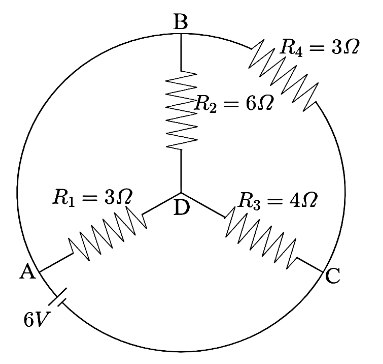
Now, from the figure above, we can see that between the points $A$ and $B$ there is a simple wire. This means that the potential at points $A$ and $B$ is the same. Hence, they can be considered as the same points.
Thus, we can see that the resistors $R_1$ and $R_2$ are connected between the same points and hence, they are said to be connected in parallel connection. Now, the combination of $R_1$ and $R_2$ is directly connected to resistance $R_3$ . Hence, this is a serious connection.
Now, the combination of $R_1$ , $R_2$ , and $R_3$ is connected between the points $A$ and $C$ and so is the resistance $R_4$ . Hence, this is a parallel connection. Hence, the above shown circuit can be redesigned as below,
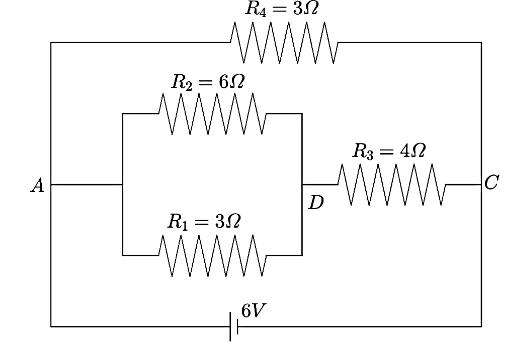
Now, we can see from the above figure that the resistance $R_1$ and $R_2$ are in parallel connection and the equivalent reaction can be calculated as,
$\dfrac{1}{R'}=\dfrac{1}{{{R}_{1}}}+\dfrac{1}{{{R}_{2}}}$
Substituting the given values,
$\dfrac{1}{R'}=\dfrac{1}{3\Omega }+\dfrac{1}{6\Omega }$
$\Rightarrow \dfrac{1}{R'}=\dfrac{3}{6\Omega }$
Taking the reciprocal on both sides,
$\Rightarrow R'=\dfrac{6}{3}\Omega $
$\Rightarrow R'=2\Omega $
Now, the circuit can be drawn as shown below,
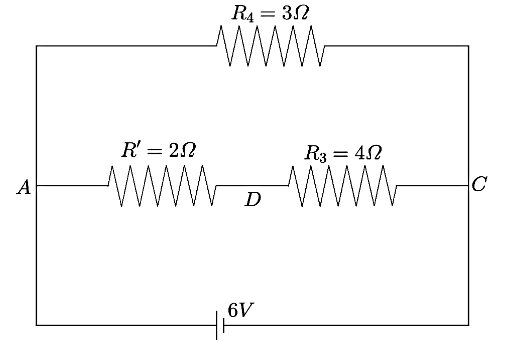
Now, the resistances $R'\;$ and $R_3$ are connected in series. Hence, the equivalent resistance can be calculated as
$R''=R'+{{R}_{3}}$
Substituting the given values,
$\Rightarrow R''=2\Omega +4\Omega $
$\Rightarrow R''=6\Omega $
Now, the circuit can be redrawn as shown below,
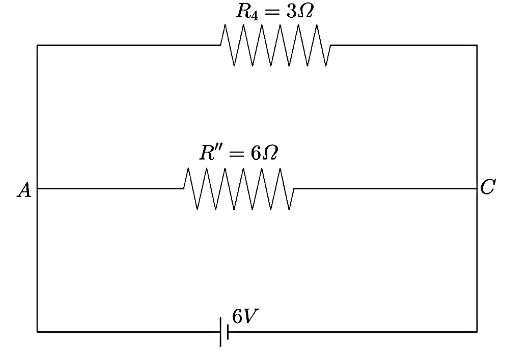
Now, the resistances $R''\;$ and $R_4$ are connected in parallel connection. Hence, the equivalent resistance can be calculated as
$\dfrac{1}{{{R}_{eq}}}=\dfrac{1}{R''}+\dfrac{1}{{{R}_{4}}}$
Substituting the given values,
$\dfrac{1}{{{R}_{eq}}}=\dfrac{1}{6\Omega }+\dfrac{1}{3\Omega }$
$\Rightarrow \dfrac{1}{{{{R}}_{eq}}}=\dfrac{3}{6\Omega }$
Taking the reciprocal on both sides,
$\Rightarrow {{R}_{eq}}=\dfrac{6}{3}\Omega $
$\Rightarrow {{R}_{eq}}=2\Omega $
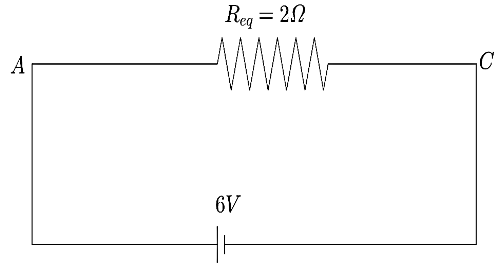
This is the total resistance of the circuit. Now, the total current can be calculated using the Ohm’s Law
$V=IR$
Substituting the given values,
$\Rightarrow 6V=I(2\Omega )$
$\therefore I=3A$
Hence, the correct answer is option C.
Note: We should note that in this type of problem, we should always start by naming the junctions in the circuit. While naming, if there is no other component other than a simple wire between the two points, then those two points are considered to be the same. We should remember that resistors are said to be in parallel when they are connected between the same two points, and they are said to be in series when they are connected in a line.
Formula used:
Series connection of resistors ${{R}_{eq}}={{R}_{1}}+{{R}_{2}}+...+{{R}_{n}}$
Parallel connection of resistors $\dfrac{1}{{{R}_{eq}}}=\dfrac{1}{{{R}_{1}}}+\dfrac{1}{{{R}_{2}}}+...+\dfrac{1}{{{R}_{n}}}$
Ohm’s Law $V=IR$
Complete step by step answer:
Let us note down the given data,
${{R}_{1}}=3\Omega $ , ${{R}_{2}}=6\Omega $ , ${{R}_{3}}=4\Omega $ , ${{R}_{4}}=3\Omega $ , and $V=6V$
Now, let us name the nodes to understand the series and parallel connections of resistors as shown below,

Now, from the figure above, we can see that between the points $A$ and $B$ there is a simple wire. This means that the potential at points $A$ and $B$ is the same. Hence, they can be considered as the same points.
Thus, we can see that the resistors $R_1$ and $R_2$ are connected between the same points and hence, they are said to be connected in parallel connection. Now, the combination of $R_1$ and $R_2$ is directly connected to resistance $R_3$ . Hence, this is a serious connection.
Now, the combination of $R_1$ , $R_2$ , and $R_3$ is connected between the points $A$ and $C$ and so is the resistance $R_4$ . Hence, this is a parallel connection. Hence, the above shown circuit can be redesigned as below,

Now, we can see from the above figure that the resistance $R_1$ and $R_2$ are in parallel connection and the equivalent reaction can be calculated as,
$\dfrac{1}{R'}=\dfrac{1}{{{R}_{1}}}+\dfrac{1}{{{R}_{2}}}$
Substituting the given values,
$\dfrac{1}{R'}=\dfrac{1}{3\Omega }+\dfrac{1}{6\Omega }$
$\Rightarrow \dfrac{1}{R'}=\dfrac{3}{6\Omega }$
Taking the reciprocal on both sides,
$\Rightarrow R'=\dfrac{6}{3}\Omega $
$\Rightarrow R'=2\Omega $
Now, the circuit can be drawn as shown below,

Now, the resistances $R'\;$ and $R_3$ are connected in series. Hence, the equivalent resistance can be calculated as
$R''=R'+{{R}_{3}}$
Substituting the given values,
$\Rightarrow R''=2\Omega +4\Omega $
$\Rightarrow R''=6\Omega $
Now, the circuit can be redrawn as shown below,

Now, the resistances $R''\;$ and $R_4$ are connected in parallel connection. Hence, the equivalent resistance can be calculated as
$\dfrac{1}{{{R}_{eq}}}=\dfrac{1}{R''}+\dfrac{1}{{{R}_{4}}}$
Substituting the given values,
$\dfrac{1}{{{R}_{eq}}}=\dfrac{1}{6\Omega }+\dfrac{1}{3\Omega }$
$\Rightarrow \dfrac{1}{{{{R}}_{eq}}}=\dfrac{3}{6\Omega }$
Taking the reciprocal on both sides,
$\Rightarrow {{R}_{eq}}=\dfrac{6}{3}\Omega $
$\Rightarrow {{R}_{eq}}=2\Omega $

This is the total resistance of the circuit. Now, the total current can be calculated using the Ohm’s Law
$V=IR$
Substituting the given values,
$\Rightarrow 6V=I(2\Omega )$
$\therefore I=3A$
Hence, the correct answer is option C.
Note: We should note that in this type of problem, we should always start by naming the junctions in the circuit. While naming, if there is no other component other than a simple wire between the two points, then those two points are considered to be the same. We should remember that resistors are said to be in parallel when they are connected between the same two points, and they are said to be in series when they are connected in a line.
Recently Updated Pages
A man running at a speed 5 ms is viewed in the side class 12 physics CBSE

The number of solutions in x in 02pi for which sqrt class 12 maths CBSE

State and explain Hardy Weinbergs Principle class 12 biology CBSE

Write any two methods of preparation of phenol Give class 12 chemistry CBSE

Which of the following statements is wrong a Amnion class 12 biology CBSE

Differentiate between action potential and resting class 12 biology CBSE

Trending doubts
What are the major means of transport Explain each class 12 social science CBSE

Which are the Top 10 Largest Countries of the World?

Draw a labelled sketch of the human eye class 12 physics CBSE

Explain sex determination in humans with line diag class 12 biology CBSE

Explain sex determination in humans with the help of class 12 biology CBSE

Differentiate between homogeneous and heterogeneous class 12 chemistry CBSE




